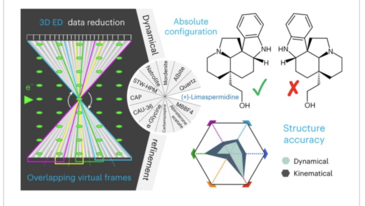Paul B Klar; Yaşar Krysiak; Hongyi Xu; Gwladys Steciuk; Jung Cho; Xiaodong Zou; Lukas Palatinus.
Nature Chemistry 15 (2023), 848 - 855
doi: 10.1038/s41557-023-01186-1
Continuous-rotation 3D electron diffraction methods are increasingly popular for the structure analysis of very small organic molecular crystals and crystalline inorganic materials. Dynamical diffraction effects cause non-linear deviations from kinematical intensities that present issues in structure analysis. Here, a method for structure analysis of continuous-rotation 3D electron diffraction data is presented that takes multiple scattering effects into account. Dynamical and kinematical refinements of 12 compounds—ranging from small organic compounds to metal–organic frameworks to inorganic materials—are compared, for which the new approach yields significantly improved models in terms of accuracy and reliability with up to fourfold reduction of the noise level in difference Fourier maps. The intrinsic sensitivity of dynamical diffraction to the absolute structure is also used to assign the handedness of 58 crystals of 9 different chiral compounds, showing that 3D electron diffraction is a reliable tool for the routine determination of absolute structures.
© 2023, The Author(s).


